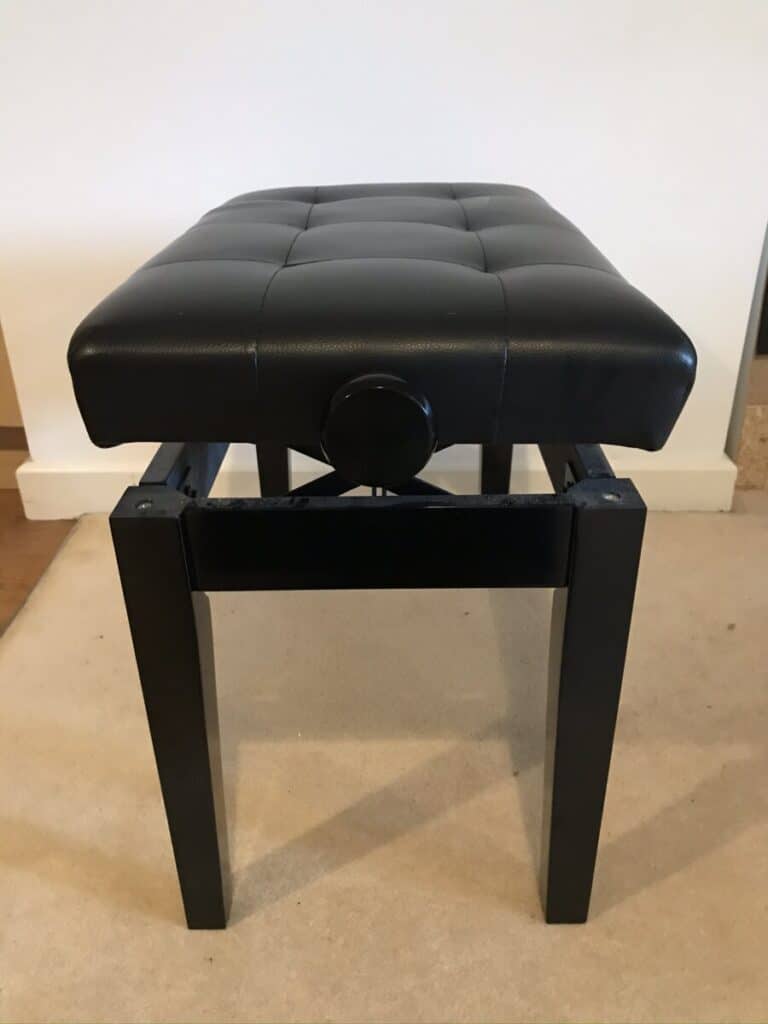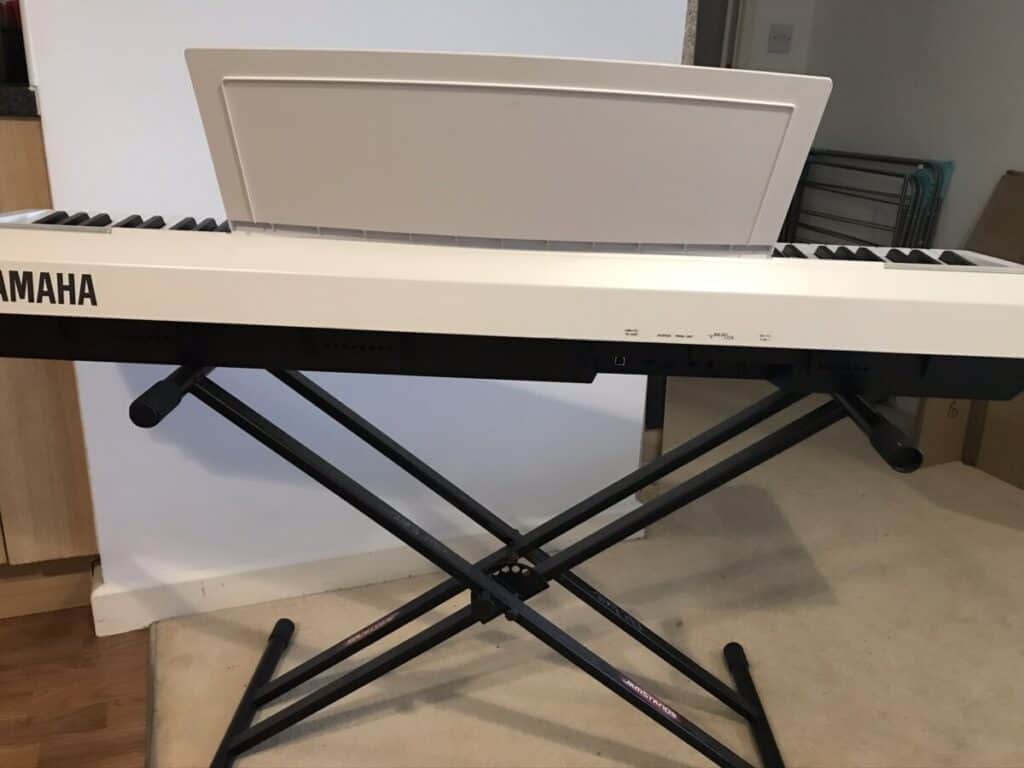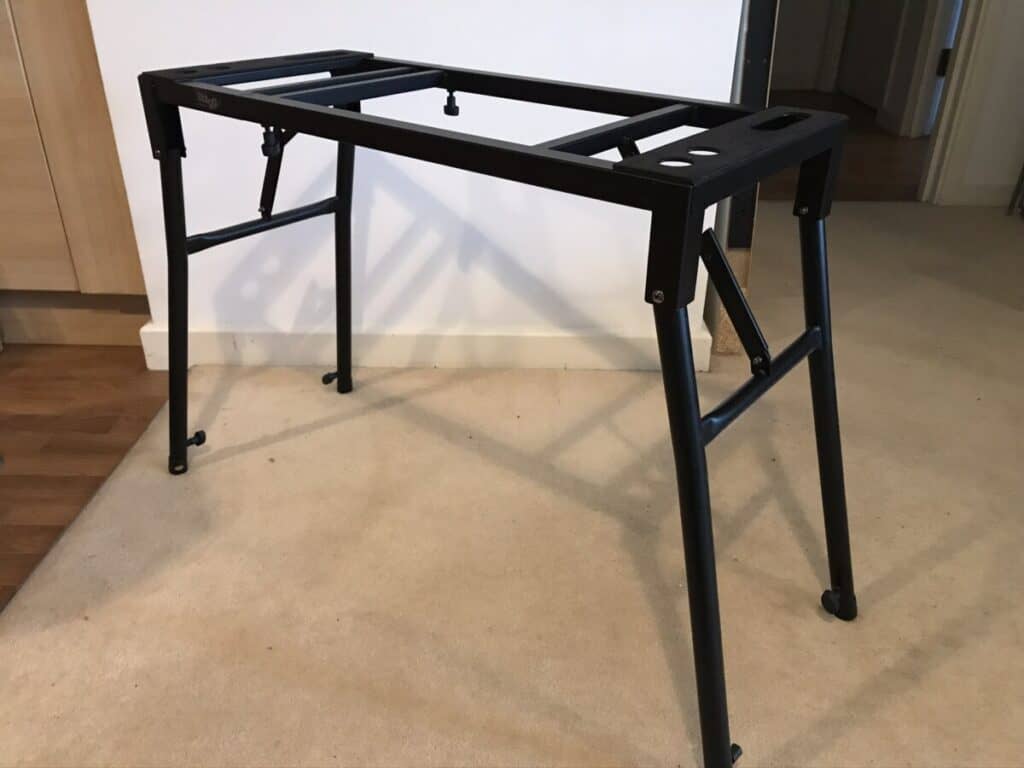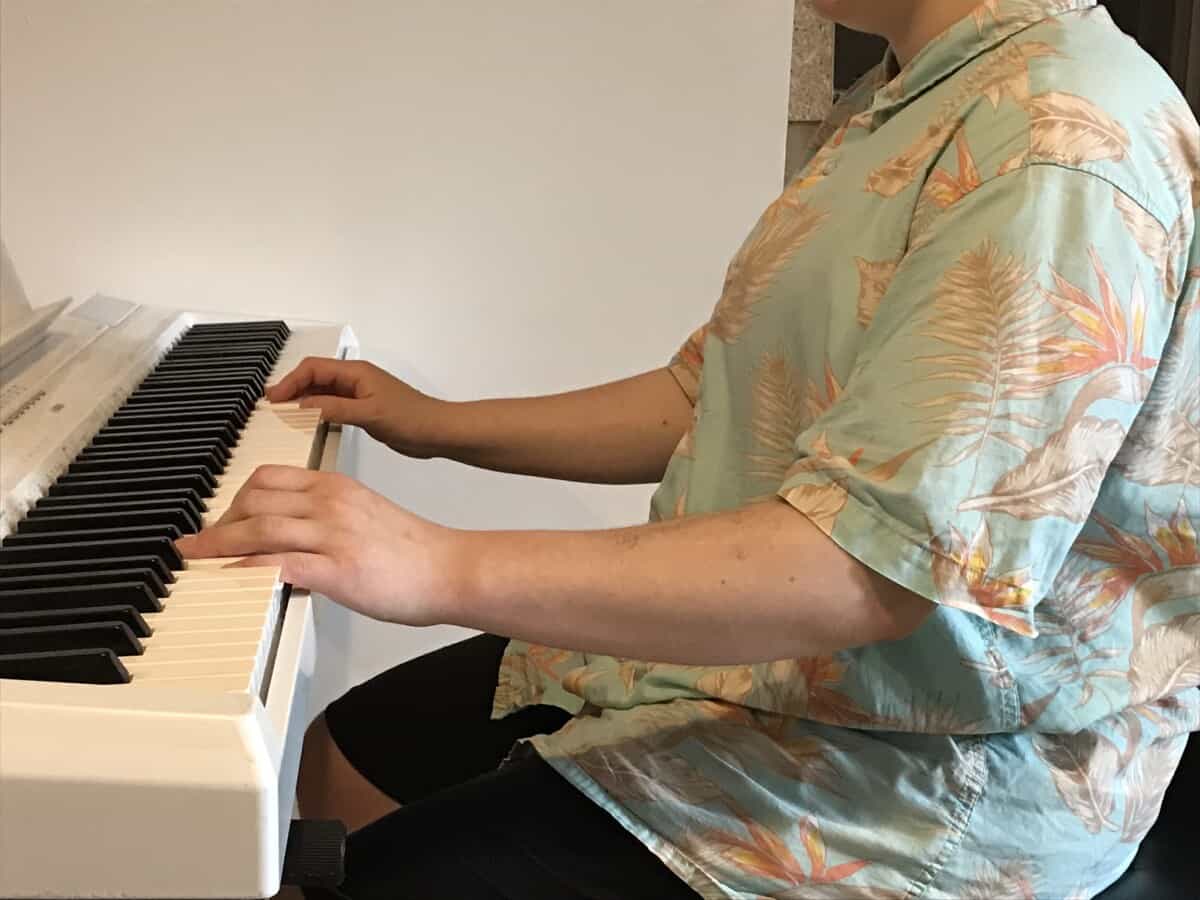Every pianist will at some point have wondered what height it is best to sit at the piano. In this article I will discuss this and some other common piano posture-related questions that my students often have:
- How High Should I Sit at the Piano?
- How Far Should I Sit from the Piano?
- Do I Need an Adjustable Piano Stool/Bench?
- How High Up the Piano Keys Should I Sit?
- Is My Child Too Small to Play the Piano?
- How High Should My Keyboard Stand Be?
- Can You Use a Table or Desk As a Keyboard Stand?
- How to Play Piano Comfortably if You Are Tall
- Why do Piano Stools/Benches Have No Back?
- Do you need a Duet Stool/Bench to Play Piano Duets?
How High Should I Sit at the Piano?
So what is the best height to sit at the piano? The best piano stool/bench height enables you to have a right angle or slightly more than a right angle at your elbow between your forearm and upper arm. Ultimately, the exact position that is best for you is going to be a matter of personal preference.
For me it looks something like this:
The stool/bench should be high enough so that your hips are higher than your knees, but your feet should be able to be placed firmly on the floor to support you.
To some extent the best posture at the piano is simply the position that you find the most comfortable and feel the most relaxed in. Here are a few factors for you to consider when thinking about how to sit at the piano:
How Far Should I Sit from the Piano?
At the piano it is best to sit far enough away from the piano so that your elbows are slightly in front of your body when you have your hands on the keys.
Many people sit at an appropriate distance from the piano, but too far back onto the stool/bench. Try moving your stool/bench backwards a few inches whilst you sit the same distance away from the piano as you were before, i.e. sit more on the edge of your stool than in the middle.
This will give you more room to lean your torso up or down when you are playing in high or low ranges. We want to avoid our forearms reaching across our body as much as possible.
Sitting closer to the front end of the stool will also enable you to move your right leg out to the side slightly to give you more support when playing really high notes, and the equivalent with your left leg when playing really low notes.
Do I Need an Adjustable Piano Stool/Bench?
After spending however much money on a piano or keyboard, it can seem ridiculous to have to fork out more money for an adjustable piano stool or bench. Won’t a normal chair do?
An adjustable piano stool/bench is the ideal option as it allows you to precisely control the height you are sitting at quickly and easily, by turning a knob at the side, to make yourself the most comfortable. Playing with poor posture for an extended period of time can lead to discomfort or injury.

Piano stools and benches can be very affordable. Check out my resources page here for my favourite stools/benches at each price point.
However, if you feel like you are not able to make that investment right now, there are some other things that you can do.
If you already own a piano stool/bench that is not adjustable but it is the right height for you, that’s great! If your non-adjustable stool/bench is too low for you, you can place a firm cushion on top of it to raise you up higher. A soft cushion may throw your balance off a bit and be more hassle than it’s worth.
If your stool/bench is too high for you, and you are able to, you can cut some length off the legs.
If you don’t have any piano stool/bench, but you happen to have a chair that is the right height for you, that doesn’t have arms at the side that restrict your movement, and has a seat that doesn’t slope backwards, then go ahead and use that chair instead!
Sitting at the right height at the piano is an important part of healthy piano-playing technique. In gigs where only a non-adjustable stool is provided that is too low for me, I have been known to sit on my coat or jumper to be at the right height at the piano.
How High Up the Piano Keys Should I Sit?
Many people think that they should sit at the piano directly opposite middle C. Despite its name, middle C is not actually the middle of the piano keyboard.
So which key should you sit opposite? The middle of a piano, or full-sized keyboard, is actually between the E and F above middle C. For a typical piece, you may find it the most comfortable to position yourself opposite these two keys. However, some pieces contain mostly low notes or mostly high notes, so it may be a good idea to adjust your position accordingly.
Is My Child Too Small to Play the Piano?
When kids are young, they are often too small to place their feet on the ground whilst being at an appropriate height to reach the piano keys.
If a young child is eager to play the piano, it is a good idea to provide them with a footstool on which to place their feet. Taller individuals use their feet and legs to balance themselves whilst playing piano, but young kids who can’t reach the floor have to steady themselves using their hands.
To avoid this unnecessary tension, having a footstool to place their feet on replicates the support that they would ideally have from the floor. Check out my favourite footstool on my recommended gear page here.
When children are too short to reach the floor yet, it follows that they cannot reach the foot pedals of the piano either. In the first year or two of learning piano, using the foot pedals is usually not yet covered, so this doesn’t matter too much.
If your child is still small at the point of learning to use the piano pedals, then a pedal extender can be used until they are tall enough. This can enable them to progress with piano as quickly as possible, and not be held back by their height. Check out my recommendations for pedal extenders on my recommended gear page here.
Sometimes kids are so small when starting to learn piano that they can’t get a comfortable position on the piano stool/bench. If the stool is adjusted to the correct height for them, that height is so high that they can’t fit their knees under the piano keys and they end up having to sit further away from the keys and hunch over to reach them. In order to fit their knees comfortably under the piano keys, the height of the stool/bench is too low.
To get around this, it is sometimes more comfortable for young children to stand up at the piano, as ridiculous as that may sound. They may need to stand on the footstool mentioned earlier, in order to reach the keys at a good height. Sometimes standing up is the most comfortable way to achieve slightly more than a right angle at the elbow for small children.
How High Should My Keyboard Stand Be?
Your setup at a keyboard can be much the same as at a piano. The average distance between the ground and piano keys is about 28 inches, so you could aim for your keyboard to be at a similar height.
Having an adjustable keyboard stand is a real advantage here. If your keyboard isn’t too heavy, then a cheap X stand (see photo below) may do the trick. Here is my favourite one on my recommended gear page.

If your keyboard is heavier, or you just want a more secure, less wobbly foundation for your keyboard, then a four-legged keyboard stand (see photo below) is a better choice. Check out the one that I use with my keyboard here on my recommended gear page.

If you are tall then I would also recommend using a four-legged keyboard stand rather than an X stand, as the crosses in the X stand can get in the way of your legs.
The other option for keyboard posture that you don’t usually have with acoustic pianos as an adult is the option to stand up whilst playing. This can be a great option if you don’t have access to a stand that goes low enough, or an adjustable stool/bench. As long as you can get a right angle or slightly more than a right angle at the elbow then this can be a comfortable choice.
One thing that often happens with me when I stand up to play at a keyboard is the pedal moves further and further from away me with each press until I have to manually retrieve it. To stop this from happening you can use blu tack or similar to temporarily stick the pedal to the floor, or put something heavy behind it to stop it from moving away from you.
Can You Use a Table or Desk As a Keyboard Stand?
If you have a table or desk that is the correct height then you can use that instead of a keyboard stand. If it is too high, and you are able to, then you can take some length of the legs to cut it to size. Alternatively, if it is high enough, you could use it to stand up and play your keyboard (see above).
How to Play Piano Comfortably if You Are Tall
If you have long legs, they don’t always fit under the piano or keyboard if you sit at your desired height. If you sit further away, you have to arch your back, but if you sit at a height that allows your legs to fit under, the angle at your elbow is too low. What can you do about this?
One option is to allow your knees to fall apart to the sides, away from each other. Whilst not ideal, this can allow you to sit at your desired height. If you are using a keyboard rather than a piano, then standing up instead of sitting down can be a much more comfortable option if you are tall.
Why do Piano Stools/Benches Have No Back?
You almost never see piano stools or benches made with backs. Why is this?
Piano stools/benches don’t have backs to encourage you to support yourself and have good technique whilst playing piano. When using a chair with a back, you can get used to relying on that for support, which can sometimes lead to poor technique.
However, that doesn’t mean that playing piano using a chair with a back is always a bad thing. If you have a bad back and are playing for long periods of time, then using the back of a chair to support you can be a good idea if recommended by your healthcare professional.
Do you need a Duet Stool/Bench to Play Piano Duets?
You may have seen those really long piano benches designed for two people to play piano duets at the same piano, and wondered if they are really necessary. Can you just choose two normal stools instead?
Using two individual piano stools/benches actually works really well for piano duets. This setup is better than some duet stools/benches, because each pianist can adjust the height of their own stool/bench independently, as well as the distance and angle from the piano.
I would advise against using a non-adjustable duet stool/bench where possible, because it is very likely that your duet partner will not be the exact same height as you. If the bench is too low for you then you can sit on a firm cushion to make yourself a bit higher, but if the bench is too high for you but a good height for your partner then there is nothing you can do about it with a non-adjustable duet stool.
What you can do instead is get an adjustable duet stool/bench where the right and left halves are adjustable independently, commonly referred to as “teacher adjustable”. This allows each player to sit at the correct height for them. You can check out my recommendation for this type of adjustable duet stool/bench here on my recommended gear page.

